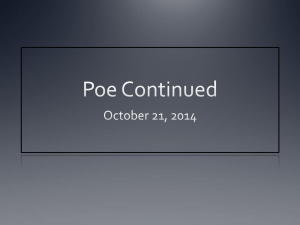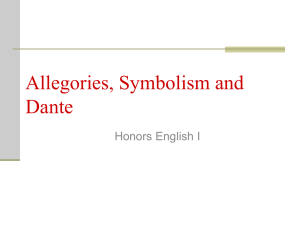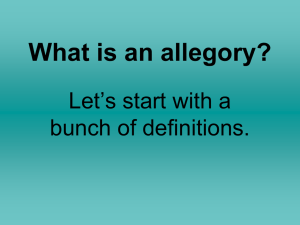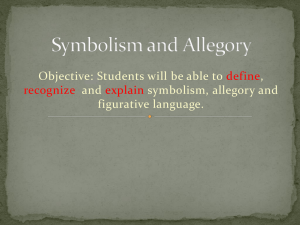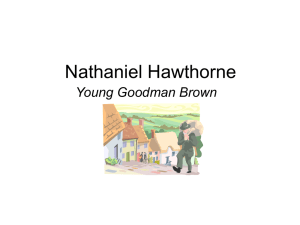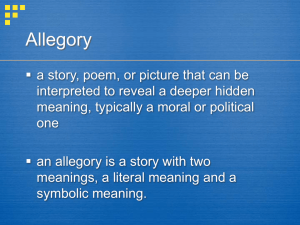Allegory - Kearny High School
advertisement
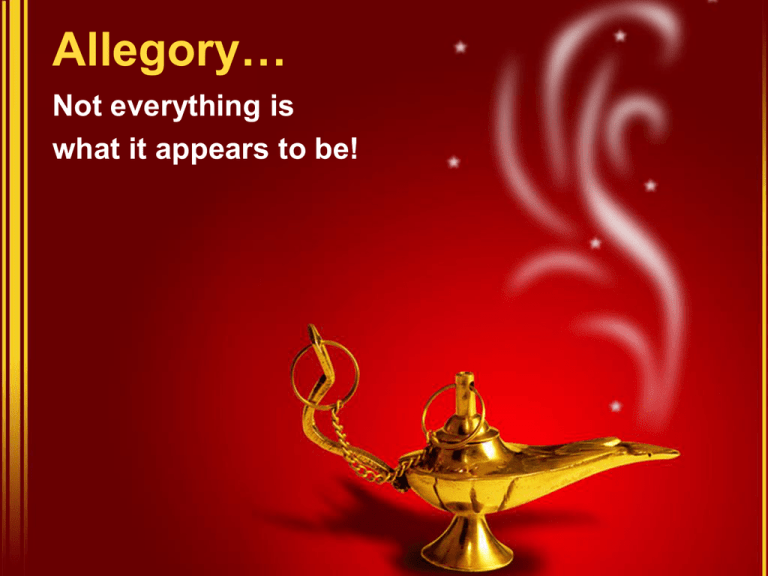
Allegory… Not everything is what it appears to be! Allegory defined • The basic meaning of allegory is "to say another thing“ or “to speak otherwise” • from Latin allegoria • from Greek allegorein "say otherwise" • allos "other" + agoreuein "speak in public” Allegory defined An allegory is… • a story that acts as an extended metaphor in which persons, abstract ideas, or events represent not only themselves on the literal level, but they also stand for something else on the symbolic level. = Faith (Character ) Faith (Belief) Allegory defined An allegory is: • a symbolic fictional narrative that conveys a secondary meaning (or meanings) not explicitly stated. • a narrative which has both a literal meaning and a representative one. Hunger Artist = Starving for attention? Dying for one’s art? Foolish devotion? Allegory defined • Poems, novels, or plays can all be allegorical, in whole or in part. These allegories can be as short as a single sentence or as long as a ten volume book. Allegory defined • Allegory is the direct opposite of the literal • Fables and parables are types of allegory Types of Allegory Types of Allegory There are two main types of allegory: • Historical /Political Allegory • Allegory of Ideas Allegory Type #1: HISTORICAL /POLITICAL ALLEGORY Historical /Political Allegory • In historical /political allegory, historical persons and events are referred to via metaphor and symbolism • Political ideas or systems may also be represented Historical /Political Allegory • George Orwell's Animal Farm is a modern example Historical/Political Allegory, describing the development of Russian communism in terms of a revolt by farm animals. Historical /Political Allegory • Lewis Carroll’s Alice in Wonderland is an example of political allegory depicting nineteenth-century British imperialism. Historical /Political Allegory • The Wizard of Oz has been interpreted as a historical/political allegory about the Populist period in late 19th century American history. Historical /Political Allegory • “Young Goodman Brown” is an allegory about the Salem Witch Trials and the Puritan mentality in general. • Young Goodman Brown = a newly initiated Puritan adult member of the community who strictly follows Puritan doctrine stands in judgment of his fellow townspeople. Allegory Type #2: ALLEGORY OF IDEAS Allegory of Ideas • In the Allegory of Ideas, characters personify abstract concepts and the story attempts to teach the audience a lesson. Allegory of Ideas • The allegory of ideas is particularly common in medieval literature, as in Dante's Divine Comedy. Allegory of Ideas • The medieval drama Everyman is another allegory of ideas, as the character “Everyman” must prepare to face death and be judged for his deeds. • (Lesson: do good deeds in life because Death may be arriving soon.) Allegory of Ideas • Many Bible stories are allegorical. For example: • The apple that Adam receives from Eve is symbolic of the “knowledge of Good and Evil” and is thus allegorical. The serpent is often read as signifying temptation or true evil. Allegory of Ideas • Fables and parables are also examples of this type of allegory. Allegory of Ideas • Lord of the Rings & The Chronicles of Narnia have both been described as allegorical (whether the allegory was intended by the authors is an ongoing debate) Allegory is Everywhere! Many movies contain allegory • The next time you watch a movie in which the characters or settings seem symbolic, impress your friends by pointing out the allegory! This would probably not impress your friends, but Allegory is always a crowd pleaser! • A humorous poster for writers about allegory: Allegory…it’s everywhere End of presentation.

